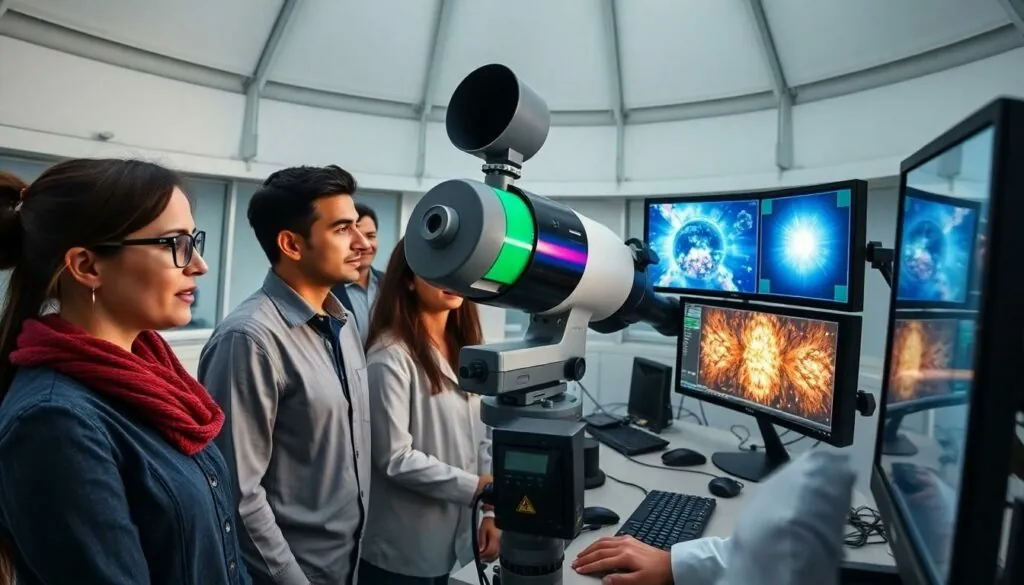Table of Contents
ToggleImagine trying to navigate a dark room with a blindfold on—frustrating, right? That’s what studying space would be like without technology that reveals the electromagnetic spectrum. This invisible world is a treasure trove of information, unlocking secrets about the universe that our eyes simply can’t see. From the warm glow of infrared to the cosmic dance of gamma rays, each part of the spectrum tells a unique story about celestial bodies.
Understanding the Electromagnetic Spectrum
The electromagnetic spectrum encompasses a broad range of radiation types, each contributing to our understanding of space. Various components within the spectrum offer insights into the composition, temperature, and movement of celestial objects.
Components of the EM Spectrum
Radiowaves, visible light, ultraviolet light, X-rays, and gamma rays comprise the key components of the electromagnetic spectrum. Radiowaves provide information on cosmic backgrounds and the structure of galaxies. Visible light enables observations of stars and planets within the spectrum visible to our eyes. Ultraviolet light reveals details about hot, young stars and the surrounding interstellar medium. X-rays uncover high-energy processes such as black holes and supernovae. Gamma rays, emitted by the universe’s most energetic phenomena, show the highest energy events, including gamma-ray bursts.
Properties of EM Waves
Waves in the electromagnetic spectrum possess unique properties essential for scientific study. Wavelength differentiates the types of radiation, ranging from long-wavelength radiowaves to short-wavelength gamma rays. Frequency, inversely proportional to wavelength, affects the energy of each type, with higher frequencies carrying more energy. Speed remains consistent across the spectrum, traveling at the speed of light in a vacuum. The ability to interact with matter varies, influencing how different types of EM radiation provide specific insights into celestial bodies. Understanding these properties assists researchers in analyzing data collected from diverse astronomical observations.
The Role of Technology in Observing the EM Spectrum

Technology significantly enhances the ability to observe and analyze the electromagnetic spectrum. Accessing various wavelengths enables scientists to uncover insights about celestial bodies not visible to the naked eye.
Types of Technologies Used
Telescopes, satellites, and spectrometers serve as crucial tools. Radio telescopes collect radiowaves to study cosmic backgrounds. Infrared telescopes detect heat from stars and planets. X-ray observatories focus on high-energy phenomena like black holes. Each type of technology specializes in capturing distinct segments of the spectrum, yielding a comprehensive understanding of the universe.
Advancements in Detection Methods
Recent advancements improve detection methods, enhancing data accuracy. High-resolution detectors now capture faint signals from distant galaxies. Adaptive optics technology corrects distortions caused by Earth’s atmosphere. Space-based observatories eliminate atmospheric interference, providing clearer data. These improvements enable thorough investigations of cosmic events and facilitate groundbreaking discoveries in astrophysics.
Importance of EM Spectrum in Space Exploration
Technology that reveals the electromagnetic spectrum transforms our understanding of space. It enables scientists to gather essential data about celestial bodies and cosmic events, enhancing exploration efforts.
Discovering Celestial Bodies
Telescopes that cover various wavelengths allow researchers to identify and study celestial objects effectively. Radiowaves detect luminous radio galaxies, while visible light reveals intricate details of stars and planets. Ultraviolet light uncovers the presence of young, hot stars, offering insight into their formation and evolution. X-ray observations highlight energetic processes associated with black holes and supernova remnants, expanding knowledge of extreme environments. Each segment of the spectrum provides unique information, promoting a comprehensive understanding of the universe’s vastness.
Analyzing Cosmic Phenomena
Technologies like X-ray detectors and gamma-ray observatories play a vital role in analyzing cosmic events. Detection of gamma-ray bursts indicates the universe’s most energetic occurrences, while X-ray data helps reveal the nature of high-energy phenomena. Observations through infrared telescopes illuminate the formation of stars within dust clouds. Radiowave analysis assists in mapping cosmic microwave backgrounds, shedding light on the universe’s early stages. These technological advancements enhance the ability to study phenomena, uncovering the complex interactions and dynamics within celestial environments.
Impact on Scientific Research
Technology that reveals the electromagnetic spectrum significantly enhances scientific research in space exploration. This technology provides insights that extend beyond the visible range, enabling a deeper understanding of the universe.
Contributions to Astronomy
Astronomy benefits greatly from technologies that analyze different segments of the electromagnetic spectrum. Radiowaves contribute to the detection of cosmic structures, allowing for studies of galaxy formations and their interactions. Visible light enables astronomers to observe stellar characteristics and planetary atmospheres with clarity. Ultraviolet light reveals the presence of hot young stars, while X-rays provide insights into energetic cosmic phenomena, including black holes. Gamma rays expose the most violent events in the universe, such as supernovae explosions. These varied wavelengths collectively enhance the knowledge and methodologies used in astronomical research.
Implications for Astrophysics
Astrophysics relies heavily on data gathered from the electromagnetic spectrum to understand fundamental processes. Wavelength analysis facilitates the study of black hole dynamics and the evolution of galaxies. X-ray observations discloses high-temperature phenomena, which are essential for models of cosmic structure. Infrared telescopes allow researchers to explore star formation incidents obscured by dust. Gamma-ray observations, on the other hand, reveal energetic explosions and particle interactions that challenge existing theories. Collectively, these implications shape the understanding of physical laws governing the universe and expand the scope of astrophysical inquiries.
The ability to see the electromagnetic spectrum is vital for advancing our understanding of space. This technology opens doors to a wealth of information about celestial bodies and cosmic events that would otherwise remain hidden. By utilizing various wavelengths researchers can unravel the complexities of the universe from the formation of stars to the dynamics of black holes.
As technology continues to evolve so too does the potential for groundbreaking discoveries in astrophysics. The insights gained from studying the electromagnetic spectrum not only enhance scientific knowledge but also challenge existing theories about the universe. Ultimately this technology serves as a key tool in humanity’s quest to explore and comprehend the vast cosmos.




